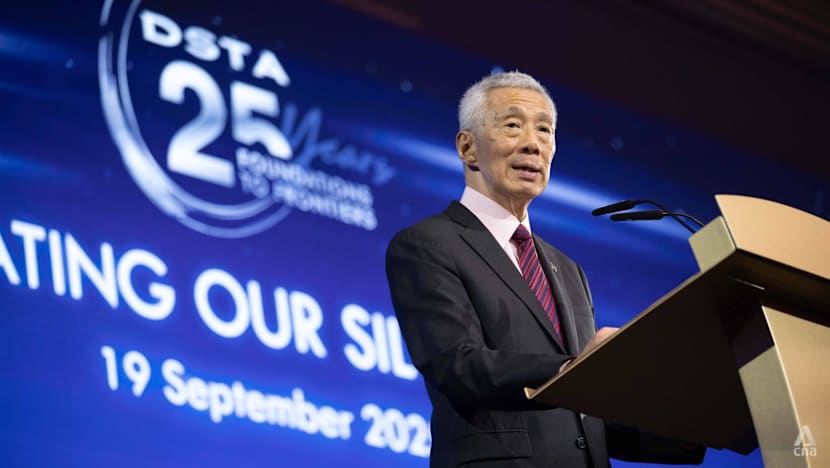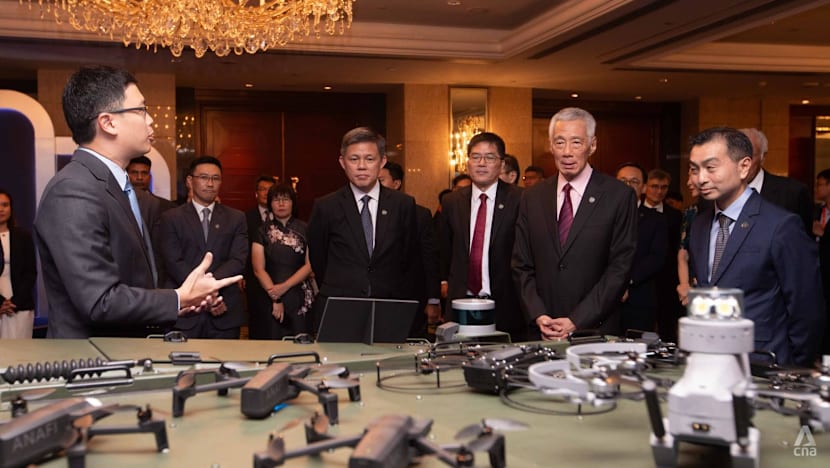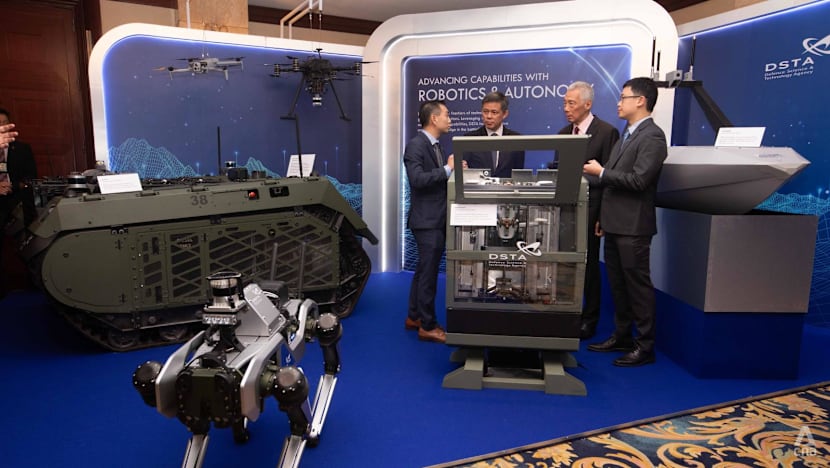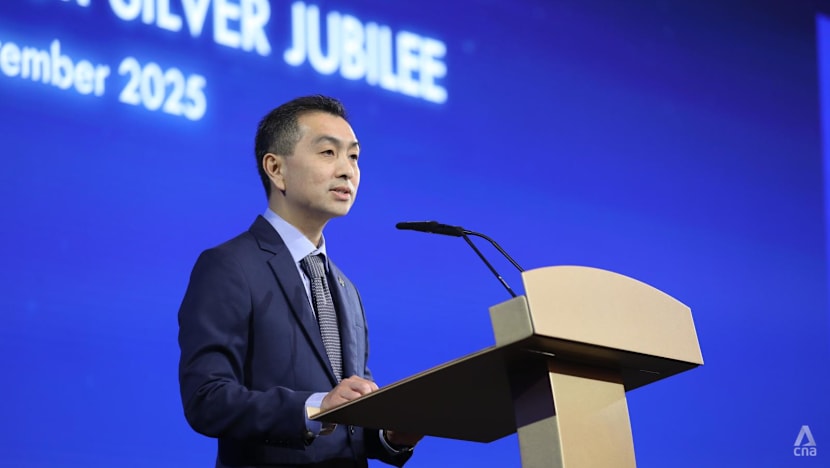DSTA must accept more risks, consider more radical changes amid shifting defence-tech paradigm: SM Lee
Singapore's Defence Science and Technology Agency must also shift its mindset to adapt to a "messier" process, said Senior Minister Lee Hsien Loong.

Senior Minister Lee Hsien Loong speaking at DSTA's 25th anniversary dinner on Sep 19, 2025. (Photo: CNA/Lim Li Ting)

This audio is generated by an AI tool.
SINGAPORE: Singapore's Defence Science and Technology Agency (DSTA) must selectively accept more risks and contemplate even more radical changes to keep up with a rapidly evolving industry, said Senior Minister Lee Hsien Loong on Friday (Sep 19).
This includes developing new procurement models, investing in more experimentation, as well as agile and continuous development to speed things up - a process that will be "messier" and less controlled.
But such an approach will better fit the new paradigm of fast-changing technologies, and the Ministry of Defence (MINDEF) and the Singapore Armed Forces' (SAF) new operating context, said Mr Lee.
He was speaking at the 25th anniversary dinner of DSTA, a statutory board under MINDEF.
During his keynote speech at the event, the senior minister spoke about the need for DSTA to innovate and deliver systems at a pace that keeps up with accelerating technology cycles.
New entrants are also disrupting the traditional defence industry model, he said, citing the likes of tech companies such as Anduril, Palantir and Helsing which have "vaulted into prominence".
Anduril is an American defence company specialising in advanced autonomous systems, while Germany-based Helsing partners with governments and industry to connect existing hardware into a new AI-enabled network. Palantir, which is also based in the US, is a software company specialising in big data analytics.
"These have become highly sought-after companies, as militaries begin to realise the value of fast-moving, innovation-driven players," said Mr Lee.
The newcomers thrive not by outspending traditional defence primes, but by outpacing them, he added.
They prioritise software-driven platforms, deploy "quick-and-dirty" solutions rapidly, and roll out improvements and upgrades one after the other, rather than "gunning for a perfect product" from the get-go.
"NEW REALITY OF DEFENCE INNOVATION"
He also noted that some of the most successful innovations may originate from low-cost, informal operations or from troops and small fighting teams on the ground using cheap dual-use technologies.
"This is the new reality of defence innovation," said Mr Lee.
He added that DSTA cannot double down on what it has been traditionally good at, such as focusing on high-end products or testing and delivering systems that "hopefully work perfectly from the start, but more often do not".
"DSTA must now pay equal, if not more, attention to how fast it can bring new systems and capabilities online, adapt them iteratively, and meet operational timelines that work for the SAF."

On considering radical changes, he said this may require organisational shifts such as what the renamed United States' Department of War tried with its Defence Innovation Unit. The organisation focuses on accelerating the adoption of commercial technology at speed and scale.
"Large organisations with traditional strengths and ways of working find it inherently difficult to move away from what worked for them in the past," said Mr Lee.
"The same tendencies that afflict organisations elsewhere apply to us too – we are not exempt from them," he added.
This applies not just to DSTA but the wider local defence industry. More local startups should be supported - rather than concentrating on a few primes - that have greater latitude to innovate and push the boundaries, said the senior minister.
MORE DRONE FOCUS, TIE UPS WITH LOCAL STARTUPS
In his speech, Mr Lee highlighted the speed at which technologies and fighting concepts and tactics are changing - sometimes within weeks and days - as seen in ongoing wars in Europe and the Middle East.
AI is used to process massive quantities of data to generate intelligence and for real-time decision-making; drones are more pervasive, accounting for 70 per cent of frontline casualties in Ukraine.
This has changed the war landscape; what is happening at the frontlines today is vastly different from when Russia first invaded Ukraine in 2022 or over at Gaza when Hamas launched its attacks on Israel in 2023.
"We must expect the same thing to happen to us, should we enter a conflict," Mr Lee said.
On its end, DSTA is focusing more on drones as well as countering them to ensure it masters these new disruptive areas; more experimentation is also done in the field, as reflected in the ongoing Exercise Forging Sabre in the US.

The agency is working with various local startups to co-develop solutions involving robotics, autonomy and AI. It also recently teamed up with Razer to adapt its gaming tech to control drones and robotics.
The partnership seeks to break new ground in how robotics can be controlled, DSTA said in a separate news release.
The effort focuses on designing interfaces that feel more intuitive and familiar, inspired by advances in gaming tech.
"Many of our younger soldiers have grown up using gaming devices, so a familiar interface can reduce training time while enhancing operational effectiveness.
"This cross-industry collaboration with Razer allows us to experiment with approaches that could inform the next generation of robotics systems," said the agency's chief executive Ng Chad-Son.

HOW SAF AND DSTA CAN WORK TOGETHER
When it comes to tech acquisition, a "healthy tension" must also be set up and maintained between DSTA and SAF soldiers, Mr Lee said on Friday.
SAF personnel and leaders must understand not just their mission needs, but what technology can accomplish for them. They must know what to demand from DSTA, have an adequate appreciation of how the tech works, while also recognising the trade-offs that their demands involve.
"They should not ask for the sky, and end up specifying gold-plated but impractical or exorbitant operational requirements. Nor should they get swept along by the latest fads," said the senior minister.
DSTA should not just see itself as a "purchaser and deliverer" fulfilling what the SAF asks; rather, it must form an independent view whether the demands make sense or can be met in a more cost-effective manner.
At the same time, the agency must be quick to alert the SAF when new technologies threaten to disrupt its whole concept of operations.
It must be prepared to debate the choices that must be made, "instead of fudging the matter and hoping to muddle through".
Apart from having technologists and tech operators work closely together, the bulk of the fighting force, National Servicemen (NSmen), should also be kept abreast of the rapidly changing tech and weapon systems.
"The SAF has grappled with this problem for decades, especially with NS units which come for in-camp training once or twice a year. But accelerating technology cycles makes this an even more acute problem," said Mr Lee.
Singapore will "lose out significantly" if new tech and equipment are changing and being deployed every few weeks or months, but it takes a year or even longer for them to reach the NSmen.
"Should the button be pressed, our men will be going out with tech they know is already several generations old, with operating systems which belong on their handphones five years ago, and which must affect their operational readiness, confidence and morale.
"We will need to figure out how to deploy and scale new technologies in the SAF, quickly but also sensibly," said Mr Lee.
















